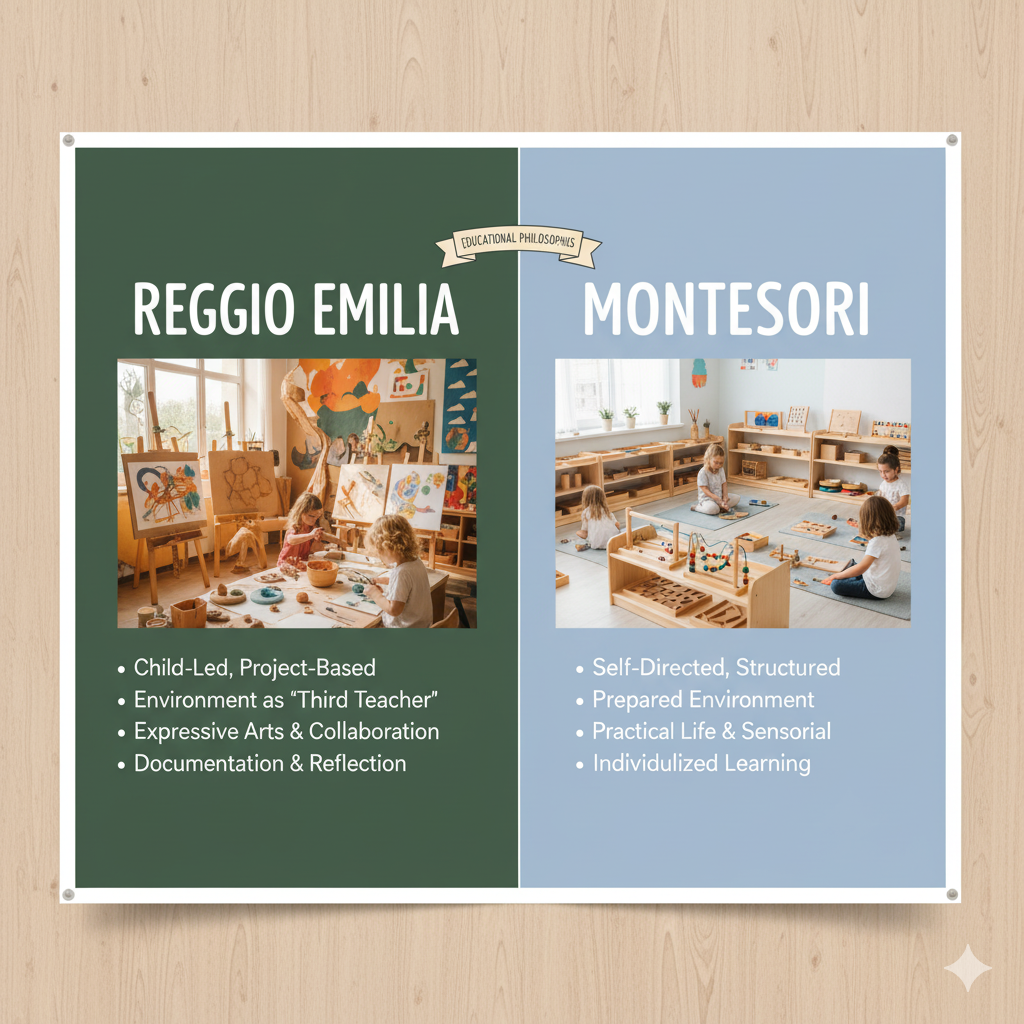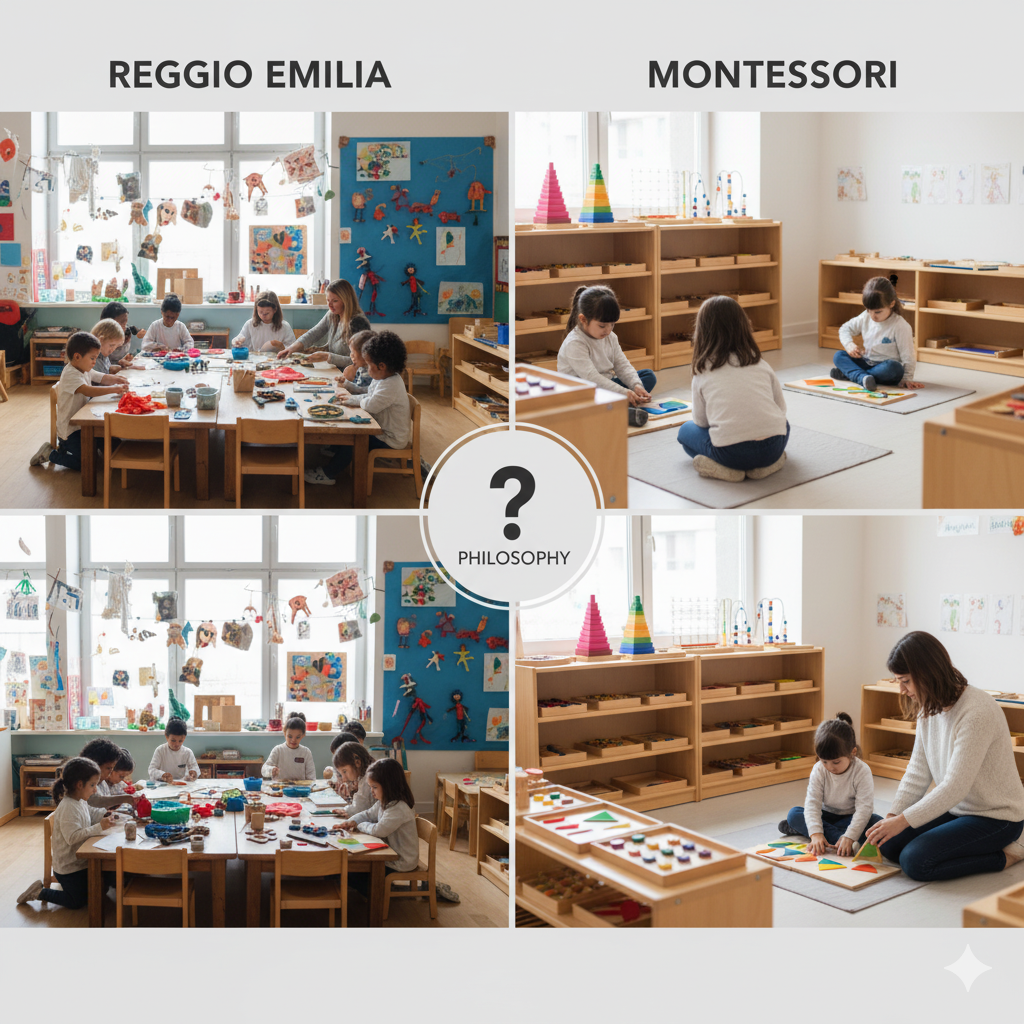Reggio Emilia vs Montessori: A Complete, In-Depth Comparison for Parents, Educators, and Researchers

Choosing the right early childhood education approach can shape a child’s lifelong relationship with learning, creativity, and social development. Among the most respected educational philosophies worldwide, Reggio Emilia vs Montessori is a comparison many parents explore in depth. Although both approaches share roots in progressive education, their frameworks, classroom structures, and developmental priorities differ significantly. Understanding these differences is essential for making informed choices—whether at a family, institutional, or state-policy level.

This comprehensive analysis explores history, principles, implementation methods, real-world examples, sociocultural impacts, integration with modern educational policies, challenges, and future prospects. It goes far beyond surface comparisons, offering a detailed resource to help you evaluate which method suits your educational goals.
Introduction to the Debate: Reggio Emilia vs Montessori
For decades, discussions around Reggio Emilia vs Montessori have gained traction not only among parents but in academic circles, teacher-training programs, governmental education departments, and rural development projects. Both philosophies prioritize child-centered learning but differ in execution. Montessori emphasizes structured independence and self-directed progression, while Reggio Emilia promotes collaborative exploration and community involvement.
Because both models empower children, encourage self-expression, and foster holistic development, understanding the nuanced differences is crucial. These differences also have broader implications for social welfare initiatives, educational equity, and women empowerment schemes where early childhood education plays a transformative role.
Historical Background of Reggio Emilia
The Reggio Emilia approach began in northern Italy after World War II. Parents, educators, and community members in the town of Reggio Emilia decided to rebuild society through innovative early childhood education. Loris Malaguzzi, a visionary educator, played a central role in shaping the philosophy. He believed children possess “a hundred languages”—various ways of thinking, expressing, and interacting.
The historical context is vital. Postwar Italy needed a system promoting resilience, democratic participation, and creative thinking. The Reggio Emilia philosophy was designed to support social reconstruction, making community collaboration a core principle. The approach thrived due to strong municipal support, making it a successful example of localized policy implementation.
Historical Background of Montessori
The Montessori method, created by Dr. Maria Montessori in the early 1900s, emerged from scientific observation of children. Montessori’s background as one of Italy’s first female physicians influenced her belief that education should be based on child development, sensory learning, and structured independence.
Dr. Montessori’s experiences with children from low-income communities shaped her perspective on dignity, self-worth, and the role of education in social mobility. As her methods spread globally, they became particularly relevant in regions prioritizing women empowerment, community upliftment, and inclusive developmental practices.
Core Principles of Reggio Emilia
The Reggio Emilia philosophy is grounded in the idea that children are capable, curious, and motivated by relationships. Instead of following a predefined curriculum, learning emerges from children’s interests. Key principles include:
The Environment as the “Third Teacher”
Reggio Emilia classrooms are artistic, inviting, and designed to spark curiosity. Light, textures, recycled materials, and open spaces encourage exploration. The environment supports creativity, social collaboration, and meaningful engagement.
Project-Based Learning
Children engage in long-term projects, which evolve through research, discussion, and collective decision-making. Teachers act as co-learners, continually documenting progress.
Documentation as Assessment
Reggio Emilia does not rely on traditional tests. Instead, educators record conversations, photos, drawings, and project notes. This documentation helps understand children’s thinking processes and informs future learning directions.
Community and Parental Participation
Active collaboration with families and local communities is central. This strengthens the connection between school and society, making it a model that integrates well with social welfare initiatives and regional development frameworks.
Core Principles of Montessori
Montessori education focuses on structured independence and self-directed learning within a carefully prepared environment.
Prepared Environment
Montessori classrooms are orderly, calm, and equipped with scientifically designed materials. Everything is accessible to the child, encouraging responsibility and autonomy.
Self-Directed Work Cycles
Children choose activities based on their interests and developmental readiness. Teachers observe quietly, intervening only when guidance is necessary.
Mixed-Age Classrooms
Montessori groups children in three-year age spans. This encourages peer mentorship, patience, and empathy.
Concrete to Abstract Learning
Materials allow children to explore complex concepts through hands-on activities. This structured progression aligns well with state-wise educational strategies focused on foundational literacy and numeracy.
Comparing Reggio Emilia vs Montessori: Philosophical Differences
Understanding Reggio Emilia vs Montessori requires examining the deeper philosophical contrasts between them.
Concept of the Child
-
Reggio Emilia views children as natural communicators who learn through relationships.
-
Montessori sees children as intrinsically motivated individuals who thrive through structured independence.
Role of the Teacher
-
Reggio Emilia: Co-researcher, collaborator, guide.
-
Montessori: Observer, facilitator, protector of self-directed learning.
Learning Pathway
-
Reggio Emilia: Emergent curriculum based on group interests.
-
Montessori: Sequenced, individualized curriculum.
Use of Materials
-
Reggio Emilia: Open-ended materials encourage creative expression.
-
Montessori: Specialized materials teach specific skills and concepts.
Classroom Structure
-
Reggio Emilia: Flexible, collaborative.
-
Montessori: Structured, orderly, predictable.
Implementation in Different Countries and States
The global expansion of both methods reveals how policies influence educational adoption.
Reggio Emilia Implementation
Countries adopt Reggio Emilia in varied forms depending on cultural readiness and policy support. Regions emphasizing community participation, social welfare reforms, and rural development often find Reggio Emilia particularly effective because of its collaborative nature.
Montessori Implementation
Montessori’s structured curriculum integrates smoothly into national and state-level education frameworks. Many Montessori schools thrive under private ownership, but governments have also adapted elements—like activity-based learning—within public systems.
Montessori methods are also popular in regions focusing on women empowerment schemes, as Montessori training often provides employment opportunities for women in both urban and rural settings.
State-Wise Impact and Regional Variations
Reggio Emilia
States with strong municipal governance and parent involvement report the highest success rates. Localized decision-making allows communities to shape learning spaces, making the approach excellent for regions promoting decentralization and community-driven development.
Montessori
Montessori’s standardized training and globally recognized materials make it easier for states to implement consistently. Rural areas benefit when teacher-training programs align with skill-development initiatives and social welfare projects.
Social Impact: Community, Women Empowerment, and Equity
Early childhood education plays a major role in shaping equitable societies. When comparing Reggio Emilia vs Montessori, both have strong but distinct impacts on social development.
Reggio Emilia Social Contributions
-
Strengthens community participation
-
Integrates parents in educational planning
-
Promotes democratic dialogue and cooperation
-
Encourages inclusive practices
Montessori Social Contributions
-
Promotes independence, confidence, and self-discipline
-
Supports early skill development, aiding long-term social mobility
-
Creates job opportunities in teacher-training and school administration
-
Aligns well with women empowerment policies in education sectors
Curriculum Structure and Classroom Experience
Reggio Emilia Experience
A day in a Reggio classroom often includes group exploration, storytelling, artistic expression, outdoor investigation, and project development. Children drive the pace, while teachers record insights and design follow-up activities.
Montessori Experience
Montessori’s three-hour uninterrupted work cycle is central. Children independently choose tasks like math materials, language tools, sensorial activities, practical life exercises, and cultural exploration. The structure helps build concentration and self-management.
Success Stories Around the World
Reggio Emilia Success Stories
-
Municipal preschools in Italy consistently rank among the best globally.
-
Many community-led rural development projects in various countries use Reggio-inspired centers to support creative learning.
-
International schools report improved communication, empathy, and collaborative problem-solving among learners.
Montessori Success Stories
-
Montessori alumni include notable innovators, artists, scientists, and leaders.
-
Public Montessori programs in several regions have shown improvements in literacy, numeracy, and social-emotional skills.
-
Montessori has also supported social welfare programs by providing accessible teacher-training to women from underserved communities.
Challenges and Criticisms
Reggio Emilia Challenges
-
Requires highly trained educators with strong documentation skills
-
Needs significant community participation
-
Implementation varies widely by region
-
Difficult to standardize for government-level policies
Montessori Challenges
-
Authentic Montessori materials can be costly
-
Quality control varies widely depending on certification
-
Some critics argue it limits imaginative play (though many modern Montessori schools address this with balanced approaches)
Reggio Emilia vs Montessori in Modern Education Policy Frameworks
Both philosophies influence early childhood education reforms worldwide.
Reggio Emilia’s Influence
-
Inspires experiential learning policies
-
Encourages collaboration in school development
-
Helps shape early education quality standards
Montessori’s Influence
-
Reinforces competency-based learning
-
Influences foundational skills policies
-
Integrates well with teacher-training programs
-
Aligns with state-wise goals for early literacy and numeracy
Future Prospects: Which Approach Will Dominate?
The future of early childhood education may not depend on choosing Reggio Emilia vs Montessori, but rather integrating the strengths of both.
Reggio Emilia Future Potential
-
Increasing global interest in creativity and critical thinking
-
Strong compatibility with community-based development models
-
Rising demand for collaborative learning approaches
Montessori Future Potential
-
Continued global expansion due to structured curriculum
-
High suitability for blended or hybrid learning
-
Strong alignment with competency-based policy reforms
Many modern schools adopt hybrid models, combining Montessori materials with Reggio-inspired project work—a balanced approach for holistic growth.
Conclusion
The comparison of Reggio Emilia vs Montessori reveals that while both approaches share a commitment to child-centered learning, they differ in philosophy, structure, implementation, and social impact. Reggio Emilia thrives on collaboration, artistic expression, and community involvement. Montessori excels at independence, structure, and self-paced progression.
The most suitable choice depends on your priorities—whether you value community-driven creativity or structured independence. In regions focusing on social welfare, women empowerment, and rural development, both systems offer valuable contributions depending on how they are integrated into policy frameworks.
Ultimately, the best educational model is one that respects the child, adapts to local contexts, and supports lifelong learning.
Frequently Asked Questions
What is the main difference between Reggio Emilia and Montessori?
Reggio Emilia is collaborative and project-based, while Montessori focuses on individual, self-directed learning within a structured environment.
Is Reggio Emilia or Montessori better for creativity?
Reggio Emilia generally places more emphasis on artistic expression, open-ended materials, and group creativity.
Does Montessori discourage imagination?
Authentic Montessori prioritizes real-life materials in early years, but modern Montessori schools often include imaginative play in balanced ways.
Which approach is easier to implement in rural areas?
Montessori may be easier due to its structured curriculum, but Reggio Emilia can thrive in community-driven rural development settings.
Are teachers required to have special training?
Yes. Both Reggio Emilia and Montessori require specialized teacher-training programs for effective implementation.
Can parents participate in both systems?
Parent involvement is welcomed in both approaches, though it is more integral and frequent in Reggio Emilia environments.
Which model is better for social development?
Reggio Emilia emphasizes collaboration and communication, while Montessori supports independence and self-discipline. Both build strong social skills in different ways.






